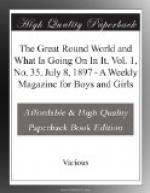[Illustration]
The Hungarians and Austrians are, however, people of very different races, and, in spite of the years they have been joined under one federal government, they have never grown to like each other.
The Hungarians are Magyars, and were originally of Asiatic origin. They are a fierce, fiery race. The Austrians come of the same stock as the Germans, and are of a much milder temperament.
Hungary is a conquered country. In the fourteenth and fifteenth centuries it was a very great kingdom, but in the sixteenth century its power declined, and, the king having died, Turkey and Austria fought for the possession of the crown, Austria eventually gaining the day.
Ferdinand I., a prince of the Austrian House of Hapsburg, was declared King of Hungary, and ever since then the Emperor of Austria has been crowned King of Hungary.
The Hungarians have never felt satisfied with the Austrian rule, and have frequently revolted. The last rising was in 1848, under Louis Kossuth. This rebellion was put down with the help of the Russians.
Last June a great patriotic celebration took place in Hungary, and this possibly roused the national feeling so strongly in the hearts of the Hungarians that it has made them a little more restless than usual.
This celebration was called the Banderium, and was to celebrate the thousandth year of Hungary’s existence as a kingdom.
The nobles of Hungary met together in Buda-Pesth, the capital city of the country, and went in procession to the Houses of Parliament, and swore allegiance to the battered golden crown which Pope Sylvester II. had given to the first King of Hungary, one thousand years before.
It was said to have been a most wonderful and stirring sight to see these nobles “dressed in the clothes their ancestors had worn, carrying the banners under which their grandfathers had fought, weeping with emotion around a battered golden crown,” a relic of the days when their fatherland was great and powerful.
The description given by Mr. Richard Harding Davis in Scribner’s Magazine for March, and from which we quote the above statement, gives a living picture of this grand festival. There can be little doubt that such an occasion must have roused the patriotism of these people to fever heat.
Whether this be true or not, it is certain that the Hungarians have been harder to manage, and that their dislike of the Austrians has been steadily gaining strength.
We spoke of a second cause of disagreement. It arises from a measure that was intended to conciliate the Hungarians.
This measure was an imperial edict, ordering that every official, in the districts where Hungarian is spoken, must be able to speak both the German and Hungarian language within five years.
This has given great offence to the German-speaking part of the population; they cannot see why they should be forced to learn Hungarian, and the Hungarians insist that no officials can properly govern a people unless they can speak their language.




